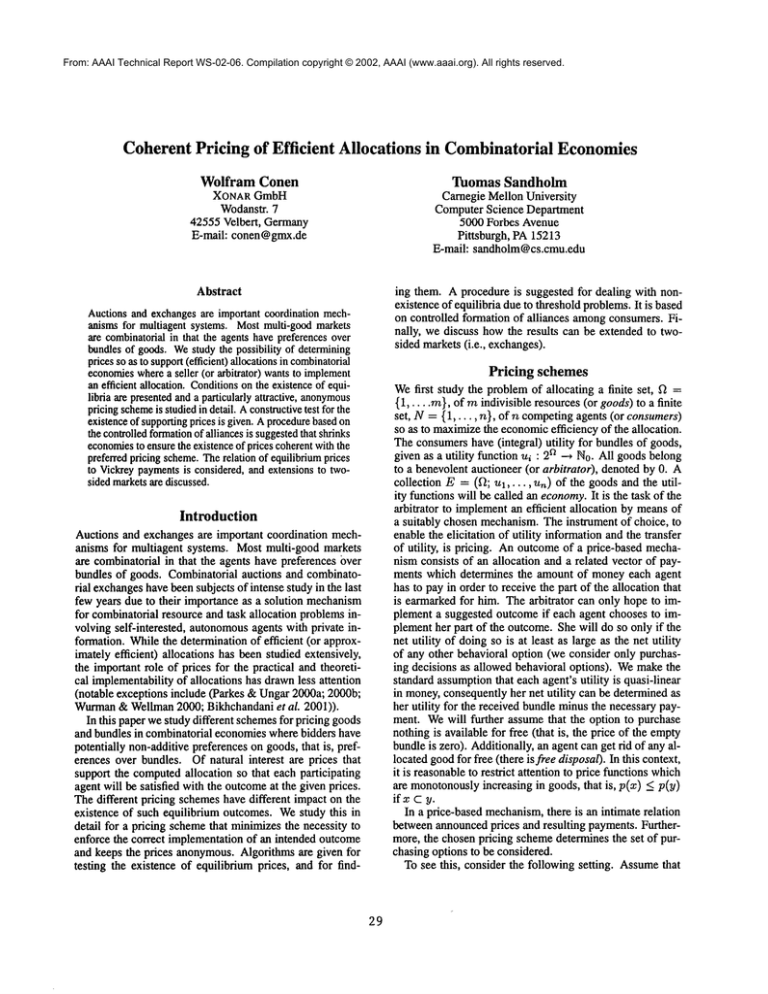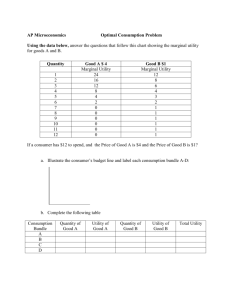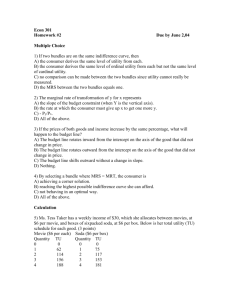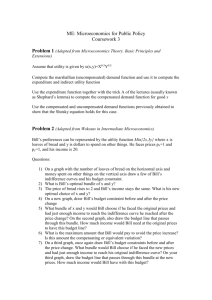
From: AAAI Technical Report WS-02-06. Compilation copyright © 2002, AAAI (www.aaai.org). All rights reserved.
Coherent Pricing of Efficient
Allocations
in Combinatorial Economies
Wolfram Conen
Tuomas Sandholm
XONARGmbH
Wodanstr. 7
42555Velbert, Germany
E-mail: conen@gmx.de
Carnegie MellonUniversity
ComputerScience Department
5000 Forbes Avenue
Pittsburgh, PA15213
E-mail: sandholm@cs.cmu.edu
Abstract
Auctionsand exchangesare importantcoordinationmechanismsfor multiagentsystems. Mostmulti-goodmarkets
are combinatorial
in that the agentshavepreferencesover
bundlesof goods.Westudy the possibility of determining
pricesso as to support(efficient)allocationsin combinatorial
economies
wherea seller (or arbitrator) wantsto implement
an efficient allocation.Conditions
onthe existenceof equilibria are presentedanda particularlyattractive, anonymous
pricingscheme
is studiedin detail. Aconstructive
test for the
existenceof supporting
pricesis given.Aprocedure
basedon
the controlledformation
of alliancesis suggested
that shrinks
economies
to ensurethe existenceof pricescoherentwiththe
preferredpricingscheme.Therelation of equilibriumprices
to Vickreypayments
is considered,and extensionsto twosidedmarketsare discussed.
Introduction
Auctions and exchanges are important coordination mechanisms for multiagent systems. Most multi-good markets
are combinatorialin that the agents have preferences over
bundles of goods. Combinatorialauctions and combinatorial exchangeshavebeensubjects of intense study in the last
few years due to their importanceas a solution mechanism
for combinatorialresource and task allocation problemsinvolvingself-interested, autonomous
agents with private information. Whilethe determinationof efficient (or approximately efficien0 allocations has been studied extensively,
the importantrole of prices for the practical and theoretical implementabilityof allocations has drawnless attention
(notable exceptions include (Parkes &Ungar2000a; 2000b;
Wurman&Weliman2000; Bikhchandaniet al. 2001)).
In this paper westudy different schemesfor pricing goods
and bundles in combinatorial economieswherebidders have
potentially non-additivepreferenceson goods,that is, preferences over bundles. Of natural interest are prices that
support the computedallocation so that each participating
agent will be satisfied with the outcomeat the givenprices.
The different pricing schemeshave different impact on the
existence of such equilibrium outcomes.Westudy this in
detail for a pricing schemethat minimizesthe necessity to
enforce the correct implementationof an intended outcome
and keeps the prices anonymous.Algorithmsare given for
testing the existence of equilibrium prices, and for find-
29
ing them. A procedure is suggested for dealing with nonexistenceof equilibria due to thresholdproblems.It is based
on controlled formation of alliances amongconsumers.Finally, we discuss howthe results can be extendedto twosided markets(i.e., exchanges).
Pricing schemes
Wefirst study the problemof allocating a finite set, f~ =
{1,....m}, of mindivisible resources(or goods)to a finite
set, N = { 1,..., r~}, of r~ competingagents (or consumers)
so as to maximize
the economicefficiency of the allocation.
Theconsumershave (integral) utility for bundles of goods,
given as a utility function ui : 2f~ ~ No.All goodsbelong
to a benevolentauctioneer (or arbitrator), denoted by 0. A
collection E = (f~; ul,..., un) of the goodsand the utility functionswill be called an economy.It is the task of the
arbitrator to implementan efficient allocation by meansof
a suitably chosenmechanism.The instrument of choice, to
enablethe elicitation of utility informationand the transfer
of utility, is pricing. Anoutcomeof a price-based mechanism consists of an allocation and a related vector of payments which determines the amountof moneyeach agent
has to pay in order to receivethe part of the allocation that
is earmarkedfor him. The arbitrator can only hope to implement a suggested outcomeif each agent chooses to implementher part of the outcome.Shewill do so only if the
net utility of doingso is at least as large as the net utility
of any other behavioral option (we consider only purchasing decisions as allowed behavioral options). Wemakethe
standardassumptionthat eachagent’s utility is quasi-linear
in money,consequentlyher net utility can be determinedas
her utility for the receivedbundleminusthe necessarypayment. Wewill further assumethat the option to purchase
nothingis available for flee (that is, the price of the empty
bundleis zero). Additionally,an agent can get rid of anyallocatedgoodfor free (there is free disposal).In this context,
it is reasonableto restrict attention to price functionswhich
are monotonously
increasing in goods, that is, p(z) < p(y)
ifz c y.
In a price-based mechanism,
there is an intimate relation
betweenannouncedprices and resulting payments.Furthermore, the chosenpricing schemedeterminesthe set of purchasing options to be considered.
To see this, consider the followingsetting. Assumethat
the arbitrator operates a shopJ Eacheveningthe arbitrator
runs an allocation mechanismon his Website which collects utility informationfromhis customersfor his goods
and bundles of goods, and which determinesan (efficient)
allocation of his goodsfrom this information. Early in the
morninghe enters his shopand executes one of the following pricing schemes:
1. Heattaches a price tag to each good.
2. Heposts a price list with a price for each possible bundle
of goods.
3. He posts a price list with a price for each possible bundie, with the additional rule: "Onlyone bundleper customer!".
4. Hebundlesthe goodsaccordingto the efficient allocation
2and attaches a price tag to eachresulting bundle.
Nowhis customersvisit the shop sequentially in arbitrary
order. Whena customervisits the shop, the customermakes
his individual purchasingdecisions, pays, and leaves the
shop. Is it possiblefor the shopclerk to determinehis prices
so that the implementationof an outcomewith an efficient
allocation is self-enforcing?
Beforewe answerthis question, let us study the consequencesof the different pricing schemesfor the purchasing
options that an agent has to consider. Assumethat agent 1
enters the shopand that his most preferred bundle, {A, B},
is still available (in a slight abuseof notation, ABwill be
used instead of {A, B} to denote the bundle if the context
allows). Now,in pricing scheme1, the paymenttl (AB) he
has to expect is the sumof prices for goodA and goodB,
p(A) + p(B). His net utility of purchasingthe bundle will
be vI(AB) = ux(AB) - tl = ux(AB) - (p(A) + p(B)).
Hewill haveto comparethis to the net utility of any other
possible bundle to makean optimal purchasingdecision.
In pricing scheme2, his calculation will be different:
instead of buying the bundle in two transaction (paying
p(A) +p(B))he mayalso chooseto buy the bundle directly
in one transaction (paying the price p(AB)).3 A utilitymaximizingconsumerwill alwayslook for the best possible
combinationof transactions to determinethe potential payment, e.g. the paymentthat agent 1 will consider for the
bundle AB will be min{p(AB), p(A) p(B)}. In pri cing
scheme3, the paymentfor a bundlethat is to be consideredis
the given price for the bundle, e.g. tl(AB) = p(AB). Pricing scheme4 is similar to pricing scheme1, with the notable
exception that neither A and B nor AB might be available
for purchasing. This wouldbe the case if they have been
’Admittedly
a special kindof shop,becausehis objectiveis
not to maximize
his incomebut economicefficiency("welfare")
among
the bidders.
2Thedecisionto bundlethe goodswouldallowus to applyeach
of the pricingschemes
1,2, and3 to the newsituation.Wewill only
considerthe analogof pricingscheme
1.
3In fact he mayalso chooseto buybundlesAand BCor the
bundleABC-even
if C doesnot addto his utility in the case that
this promisesa better deal - however,the assumedmonotony
of
prices makesthis type of considerationsunnecessary,so wewill
leavethis aside fromnowon.
30
packagedinto bundles containing other goodsas well, say
ACand BD,so the paymentthat agent 1 has to consider is
the best obtainable price or sumof prices for a bundleor a
collection of bundlesthat contains the consideredbundle.
Coherent prices
Tomakethis moreprecise, someformalization is necessary.
Wecould continue to study the paymentsthat result fromthe
prices. Adifferent possibility is to considerpricing scheme
3 only (here, the paymentto be considered for any bundle
is equal to the given price) and to mapthe other pricing
schemesinto coherenceconditions on the structure of the
prices of scheme3. First, someterminologyis required.
Definition I (Allocation, Outcome,Value). An allocation
is a vectorized partition X = (X1,..., X,~) of the goods
in f~, such that [-JicN Xi = f~ and Ni~NXi = 0 (because
of the free disposal assumption,we can safely assumethat
all goodswill alwaysbe distributed). A 2n-ary vector (X1,
..., X, ; t l , . . . , t,~ ) will be calledoutcome/f(X1,
¯ ¯ ¯, Xn)
is an allocation andti >_0 for all i E N (note that these
values are paymentsto be nw.de, so, in contrast to their
sign, they havea negative effect on a consumer’sutility).
~ielv ui(Xi) is the value of an allocation respectively an
outcome.
Definition 2 (Net utility of implementation).
Let
Then
( Xl, . . . , Xn; tl , . . . , tn) be an outcome.
vi = ui(Xi) - ti is the net utility of an implementation of the outcomefor consumeri E N.
Weassumethat each consumercontrols her behavior autonomously(cannot be forced to purchase a bundle) and behavesindividually rationally (does not pay morefor a bundle
than it is worth). Anoutcomeis not implementable
ifvi <
for any i E N. The(rational) objective of each consumers
it to maximizeher net utility whenpresented with a choice
of options. As has been said above, we will consider purchasing options only (though this will be extendedbelowto
a formof controlled collusion). The available options are
determined by the pricing scheme. A (monotonous)price
function and the coherenceconditions for the different pricing schemescan nowbe defined as follows.
Definition 3 (Price function). Let E = (D; ul ..... Un) be
an economy.Wecall a function p : 2n --~ I~+a price function,/fp(0) : 0. (Abusing notation, we sometimesspeak of
a price vector and write Px instead ofp(x).)
Definition4 (CoherentPrices). A price function p : 2~ --*
No, to be used with pricing scheme3, is coherent with
scheme1 respectively 2, if
p(x) = Ep({z}) Vz _C a,x ¢
(1)
zE~c
respectively
p(x)= Z~II(~)
min ~p(z)
zeg
VxC_Ft,
x¢¢
(2)
Above,II(x) is the set of all possible partitions of x. Furthermore, every price function is coherent with scheme3.
Forscheme4, the coherenceis relative to an allocation, that
is, p(.) is coherentwith pricingscheme4, if an allocation
4exists suchthat
and
p(x) raXin p( z) Vx ~[ x,x S~ O (4)
zDx~zE2
Wealso say that the prices are coherentwith the allocation
X.
Further on, wewill assumethat the setting is that of scheme
3 (at most one bundle per consumeris allowed). Note that
the followingobservationholds
Prolmsition5. Let p(. ) be a price function~If p(. ) is coherent with scheme1, it is also coherentwith scheme4. If p(.)
is coherentwith scheme4, it is also coherentwith scheme2.
Proof. Please, see the appendixfor left-out proofs.
[]
Pricing schemes1 and 3 have been studied extensively in
the literature (see (Kelso & Crawford1982; Gul &Stacchetti 1999) for scheme 1 and (Wurman& Wellman2000)
for scheme3). Both mayhave showdeficiencies. Prices
in scheme1 that self-enforce (or, a little bit weaker:support) efficient allocations are only guaranteedto exist under rather weakconditions (gross-substitutes). Whilesupporting prices in scheme3 do alwaysexist, they require
strict meansof enforcementto ensurethe "correctness"of an
implementation--inthe above example, enforcing the rule
on the sign wouldrequire to register the customers(to prevent them from makingmultiple purchases throughout the
day). It wouldalso be good to prevent themfrom sending
in a friend that acts as a buyerand hands his purchaseto
the original agent. Suchenforcementis certainly not viable
or desirable in all settings, especially on the Internet where
pseudonymstend to be cheap. Wewill therefore focus on
pricing scheme4 (we will sometimeswrite coherent prices
instead of prices coherentwith scheme4).
Now,as the dependencyof the purchasing decision on the
pricing schemeis hiddenin the coherencecondition, wecan
usethe pricesdirectly in the definitionof the net utilities that
are to be considered.
Definition6 (Net utility function). Let [2 be a set of goods,
p(. ) a suitable price function, andi a consumer
with a quasilinear utility functionbasedon ui(’). Thenthe functionv~i
2n --* N, definedas v~i (x) =ui(x) - p(x) will be called
netutility functionof i withrespectto [2 andp(. ).
*Tounderstandthe followingnotationnotethat powerset and
element-of
operatorare usedhereona partitioningsequence
Xin a
canonicalextensionof their usualmeaning.Theelementsof Xare
the sets Xi C_fL Thepowerset 2x consists of all combinations
of
the elementsof X. Wewrite x E 2x for a x c_ [2 if a partition of
x existssuchthat everyelement
of the partition(itself a subsetof
t) is an elementof X(in other words:the partition is an element
of 2X).
31
Let us return to the aboveexampleand considerthe first customer,say i, enteringthe store. Sheis faced with the whole
rangeof purchasingoptions. Let us restrict our attention to
prices that are coherent with scheme4. To makeher purchasing decision, she will have to pick the optimal wayto
purchaseeach bundle. Becauseof the coherenceconditions,
it is nownot anymorenecessaryto consider multiple transactions - the one-transactionprice given for a bundleis already minimal.She will have to comparethe obtainable net
utility withthe net utility relatedto anyother bundle,that is,
she has to solve the problemarg maxxc_a
v~/(x) at the given
prices p.
Equilibria
Toease the treatment of race conditions and indifference,
we will switch nowfrom a shop environmentto a distribution environmentwheregoods and bundles are presented in
a catalog. Oncethe arbitrator has determinedan efficient
allocation fromcertain valuation information,he will determine prices coherent with the chosen pricing scheme. He
will then send the price list (and the additional conditionof
scheme3) to the participating consumers. Each consumer
will determinea set B containing all bundlesthat maximiTe
her net utility at the given prices. She will then submita
list of mutuallyexclusiveorders of individual bundles,containing all bundlesfromB. Oncethe arbitrator has received
the orders, he will distribute the goodsto the customersso
as to maximizeefficiency. If a customerreceives one of the
requestedbundles, she will be satisfied with the outcome.If
every customerreceives a requested bundleand if the objective of the arbitrator is fulfilled by the resulting allocation,
the outcomedeterminesan equilibrium.
Definition 7 (Satisfied, Supports). A consumeri is satisfied with an allocation X at given prices p(.), iff the bundle
Xi he receivesmaximizes
his net utility, that is
¢,(x,) >
c a.
Theprice function supports an allocation X if every actor
i E N is satisfied with X.
Definition 8 (Equilibrium). Let 17, be an economy,X an
allocation, andp(. ) a price function. Thepair (X; p(-)) is
an equilibrium(of interests), if every participantis individually satisfied with the inducedoutcome.In the considered
situation, this corresponds
to
Arbitrator(X1, . . . , X,~)is an efficient allocation.
ConsumerEvery consumeri E N is satisfied with Xi.
If such an outcomeexists for an economyand a given price
function, the price function will be called an equilibrium
price function.
Consequence
9. Note that the following are immediateconsequences and hold for any equilibrium outcome:(1) Demandequals supply-in other words: the outcomeis imple5mentable,and(2) the supportedallocation is efficient.
sWithout
considering
incentivecompatibility,this is onlytrue
withrespectto reportedutilities.
It mightbe surprising that one of the standardresults, the
first theoremof Welfare economics,has been turned into
a definitional consequence-namely
that every equilibrium
is efficient. This is due to the situation understudy: the
key property of an equilibrium is that all actors are individually satisfied with the result. Here, one of the actors
(the arbitrator), has preferencesfor completeallocations,
whichexplains the fact that a global social criterion (efficiency) coincideswith a criterion for individual satisfaction. In the classic setting, with a set of sellers and no central and self-interested arbitrator, all actors havepreferences
only for their part of the allocation-in that situation, it becomesimportantto analyzeif a global criterion (efficiency)
is an emergentconsequence
of satisfied individual criteria.
In our setting, on the other hand,this is immediate.
A
B
Utility Agent I
5
5
Agent 2
0
3
Agent 3
0
0
Prices Schemes 1,2,4 <_ PB <_3
Scheme 3
1
2
AB
5
3
7
PA-I-PB>--- 7
7.1
Wewill, however,demonstratebelowthat the initial economycan be modified without an impact on efficiency such
that equilibrium prices coherent with scheme4 exist. The
basic idea is to shrink the economy
by creating alliances of
agents that submit joint bids. Reconsiderthe aboveexample
with an alliance of agents 1 and 2.
Utility
Agent (1+2)
Agent 3
Scheme4 prices
A
5
0
7
B
5
0
7
AB
8
7
7
Existence of supporting prices
Computing the prices
Before we study this in more detail, we present a constructive test for the existence of prices that are coherent
with scheme4. Weassumethat an (efficien0 allocation
X = (X1,..., Xn) has been determined and the task
handis to computeprices, coherent with scheme4, that support this allocation.
We first study a reduced economy E~ = (~q~
{el,..., g,}7; u[,..., u~) whichresults from the original
economyE as follows: gi = Xi and u~" : 2~r ~ 1~1 defined
as u[(x) = ui(x) for all i E N and x E 2f~r. Obviously,the
8following holds
Proposition12. Thevalue ~ieNui ( Xi ) of the efficient allocationX in E is equal to the value of an efficient allocation in the reducedeconomy
Er. In particular, the allocation
~
X = (91,..., 9,~) is efficient.
Consider nowthis efficient allocation X~ for a reduced
economyEr. The following algorithm will computeprices
supportingX~ if the consideration of utilities is further
restricted to utilities for the goodsonly. Basedon these
prices (which alwaysexist, see below), extended equilibrium prices for the reduced economyand complete prices
for E can be determinedif they exist. Below, J collects
the agents i whichneither request the earmarkedbundleXi
nor a goodthat represents an emptybundle. If this set is
empty,either X~E Yi for all i E N(supporting prices have
been determined) or no such price vector could be determined (this cannot happen as we will show below). The
vector A measuresthe attractiveness of the goodsin Yi rel-
Akey questionfor the arbitrator nowis if, for everyresource
allocation problemand a givenpricing scheme,a price function exists that supportsan efficient allocation. This is the
case for pricing scheme3:
Proposition 10. For any economyE and pricing scheme3,
an outcomewith an efficient allocation and a supporting
price functionexists.
This has been shown in (Wurman& Wellman2000) as
consequenceof results presented in (Leonard1983)). Such
a result does not hold for scheme1, as the followingsimple
exampledemonstrates:
Utility
Prices
Agent 1
Agent 2
Scheme 1
Schemes2,3
Scheme 4
A
0
2
2
2.1
2.5
B
0
2
~2
2.1
2.5
AB
3
2
p(A)+p(B)g3
2.5
2.5
Fromthe conditions that follow from the necessity to satisfy both agents, a contradiction follows immediately.The
prices givenfor the other schemesare, in contrast, equilibriumprices.
As we stated above, we consider pricing scheme4 the
schemethat combinesa significant design flexibility (it allowsus to solve an extendedset of allocation problemscompared to scheme1) with a reducednecessity for enforcement
(in contrast to scheme3). However,scheme4 does not solve
all existenceproblemsthat are due to combinatorial(that is,
non-additive)preferences immediately,as the followingex6ampleof a threshold problemdemonstrates:
7Someof the goods may represent empty bundles.
SWe
can nowalso formulatethe missingexistenceproposition:
Proposition11 (Individualistic ExistenceCondition).Let E be
an economy
andX an efficient allocation. Let Er be the reduced
economy
obtainedfromthe constructionabove.If the reducedutility functionssatisfy the grosssubstitutesconditionof Kelsoand
Crawford(see (Kelso &Crawford1982) or (Gul &Stacchetti
1999)for alternativeformulations),an equilibriumcoherentwith
scheme
4 exists.
6Existence
canbe guaranteed
if the gross-substitutescondition
from(Kelso&Crawford
1982)holdsfor utility functionsthat are
restrictedto the bundles
in the efficientallocationandtheir super
bundles.Thisis an immediate
consequence
of Theorem
3 in (Kelso
&Crawford
1982).Thepropositionfollowsbelow,oncethe notion
of restrictedutility functions
is formalized.
32
ative to the attractiveness of the earmarked
goodgi for each
9agent i.
Algorithm Min-Pricing
(1) p = (0,..., 0); ComputeY; ComputeA; Compute
(2) while d ~ 0
(3) i = arg mo.xj~3
(4)
Forall y ¯ Y~do
(5)
Py = Pu + Ai
(6)
Compute Y; Compute A; ComputeJ;
Theorem13. The algorithm Min-Pricing determines, for a
given reducedeconomyEr and a correspondingefficient allocation Xr = (gl ..... gn), prices p, so that
ui(gi) -Pg, >_ ui(gj) -pg~ Vj ¯ {gl,..-,gj},Vi
¯ N
Furthermore,this price vector is minimal.
A similar algorithm, Max-Pricing,can be given for computing maximalprices, that is, prices whichcannotbe increased
without makingone of the efficiently allocated "goods"
unattractive to the prospectivebuyer.
The determinedprices are solutions to dual linear programs (compare (Koopmans& Beckmann1957; Gale 1950;
Leonard1983)) that give minimaland maximalequilibrium
prices for economiesin whichthe bundling of goodsdoes
not increasethe utility of the individual consumers:
Definition 14 (Assignment Economy).An economyE will
be called assignmenteconomy,if ui(x) = maxzezui( { z}
for all i ¯ N and x c 12.
Everyprice vector determinesa different distribution of the
value of an allocation to the consumersand the arbitrator. Minimalprices maximizethe surplus of the consumers,
while maximalprices maximizethe surplus of the arbitrator. In the above,werestricted our attentionto a certain part
of the utility functions. Onceweextend this to include the
bundles that can be formed from goods in f~r (which may
inlxoduce complementarities),the resulting impact on the
existence conditions for equilibria mayexcludethat prices
coherent with scheme4 exist.
Theorem15. Let E be an economy,X an efficient allocation, and Ea the reduced assignmenteconomy.Let Paaxbe
maximalprices supporting the reduced allocation Xa for
E~. Let pe be the result of extending1° Paaxto a complete
price function. If (X,pe) is not an equilibrium (coherent
with scheme4 and X ), no such equilibriumexists.
In somecases, the minimalprices for the reduced assignmenteconomycan also be used to determine Vickrey paymerits. Consider the following exampletaken from (Gul
&Stacchetti 1999): There are three identical objects and
two consumerswith the same preferences, ui(A) is 0 for
9Formally: Empty= {jlX~ = 0}, Y~ = {x ¯ f~rlu,(x)
pz > u,(y)-py Vy ¯ f~r}, j = {i ¯ N : Xi ¢~ Y~
~tx ¯ Yi with x E Empty},and Ai = (ui(y) --py) (ui(X,) PX,) Vi and somey ¯ Y~.
l°Extendingpricesfollowsthe coherence
conditionsfor scheme
4: All bundlesof gi’s are pricedadditively,thenall otherbundles
will receivethe price of the smallestbundlecontainingit. Asall
goodsare distributedin X%
sucha bundlealwaysexists.
33
#(A) = 0, 10 for #(A) = 1, 18 for #(A) = 2 and
#(A) = 3. It is an efficient allocation to give one goods
to one buyer and two goodsto the other. The Vickreypayments are 2 for the one-goodbuyer and 10 for the other.
The(minimal)Walrasianprice accordingto the definition
(Gul &Stacchetti 1999) (which coincides with our scheme
1) is 8 for each good, minimalcoherent prices for scheme
are 2 for the singleton and 10 for the two-goodbundle(with
respect to any chosenefficient allocation, necessarily consisting of a singleton and a bundleof twoof the goods.).
Theabovealgorithmsgive meansto test for the existence of
equilibriumprices for scheme4 and to determineif equilibrium prices exist that equal Vickreypayments.If no such
prices exist (see the "threshold" exampleabove), the arbitrator maychooseto ask selected agents to cooperate("collude") if this promisesto be beneficial. Thiswill be formalized and analyzedin the next section.
Shrinking the economy
Definition 16 (Alliance). Let K = {1,..., k}_ C_ N be a
set of agents and [c an additional agent. Thenk represents
an alliance respectivelyan efficient alliance of the agentsin
K,if
n
<
i=k
respectively
n
(x) = max
i=k
for all x C f~ andall k-ary sequencesX partitioning x.
Definition 17 (ShrunkenEconomy).Let E = (f~; ux, ...,
Un) be an economyand P = {P1,- - -, Pk} be a k-ary partition of N, with P~¢ Ofor all i ¯ {1,... ,k}. Additionally,
let fi~ ={ i, . . . , [~} be a set of agentswithk elements,such
that for all i ¯ {1,..., k}, i is an alliance of the agentsin
Pi. Then, ER = (f~; ui, ... , u~ ) will be called a shrunken
economy
with respect to E and P. If all ~s are efficient alliances, ER is an efficiently shrunkeneconomy.
Wewill only consider efficiently shrunkeneconomiesbelow.
First, note the following:
Proposition 18. Let E be an economy,[( a set of efficient
alliances, ER the correspondingefficiently shrunkeneconomyand X an efficient allocation of ~ with respect to N.
ThenXR = ([-Jia~Pt Xit, ..., UikGPk Xik) is an efficient
allocation with respect to ER. In turn, an efficient allocation XR for a shrunken economydetermines one or more
efficient allocationsfor E: for everyi ¯ {1, ..., k ), a [Pi[ary allocation Yi of the goodsin X[~ to the agentsin Pi can
be found, such that ~JePkui(Yi) will be maximizedfor all
possibleIPd-ary
allocations (Yi is not necessarily unique).
A suitable renumbering
of Yi will lead to an n-ary allocation
Xi whichis efficient with respect to E.
Theseresults are immediateconsequencesof the definition
of efficient alliances. Nowlet E be an economy.The set of
all possible partitions consisting of non-empty
subsets of N
will be denotedwith 79N.For every partition P 6 79N,a set
KP of agents can be constructedsuch that every agent represents an efficient alliance of the corresponding
part of P-the
existence of such a set follows immediatelyfromthe existence of an efficient allocationand the definitionof efficient
alliances. Let.Abe the set of all suchpairs (P, KP).It determinesthe set of all possible efficiently shnmken
economies
£~t with respect to E, whichstarts from considering all
agents as a singular alliance and ends with considering the
grandalliance whichrepresents all agents in N.
Proposition 19. The set £ C E~ of e~cient allocations, for
whichequilibriumprices exist that are coherentwith scheme
4, is not empty(this extendsto schemes2 and1).
This follows immediately by taking the reduced economy
with one agent only whorepresents the grandalliance. Here
(with reservation values of 0 of the arbitrator, as assumed),
the minimalequilibriumprices are 0 for each bundle.
Wewill nowconstruct a procedurethat picks one of the
economiesfrom £ and determines an equilibrium. This will
be doneiteratively by determiningin each roundan alliance
to formin a waythat ensuresthat the alliance is attractive
for the participating agents (relative to a certain policy of
the arbitrator that determineshowto proceedif the agents
wouldobject against the alliance, see below).
ProcedureShrink(EconomyE, Efficient allocation X)
(1) Determinethe maximalprices Pma~for the assignment economyEa that corresponds to E and X. Extend the
obtainedprices to prices coherent with scheme4.
(2) If the equilibriumconditions are violated for one
more bundles, choose one such bundle Y (Note: ui(y)
P(Y)> v.i(Xi) -p(Xi) for at least one i). If no condition
violated, terminate with the shnmken
economy
E as a result.
(3) Createan alliance a fromthe agents that receivea part
of the chosenbundlein the efficient allocation-a represents
I = {i 6 NIX~ C Y}- Create a new good Xa representing
the set {Xi E Y}, i E I. Removeall goods {Xi 6 y}
from12 and insert X,, to create ~-. Determinethe utility of
a for all bundlesz _C fZ- so as to maximizethe utility of
distributing z among
the agents in I.
(4) Remove
nowall agents I from N and add a to create
N-. Removeall goods {Xi 6 Y} from X and add Xa to
create X-. Choosea suitable index of the agents in N- and
order the elements of X- so that each agent i will receive
the bundle Xi--. RenameX-,N-, and 12- to X,N, and 12.
Continuewith (1).
Proposition20. Starting from economyE and efftcient allocation X, procedureShrink determines a shrunken economyE-, an allocation X- and a price vector p such that
1. X- is an e Sicient allocation of the goodsin E- andthe
value of X- is equalto the value of X in 17,
2. p is an equilibrium price vector for the shrunkeneconomy
coherent with scheme4 and the computedallocation X-.
If it is the policyof the arbitrator to chooseprices that support an inefficient but implementable
allocation in the case
that a suggestedalliance does not form(that is, at least one
agent objects against its formation),it becomes
attractive for
34
the agentsin the alliance to acceptits formation:in the above
example, an arbitrator with this policy wouldsell AB to
agent 3 for a price of 5 (whichcan immediatelybe extended
to prices coherent with scheme4: p(A) --- p(B) = p(AB)
= 5), makingit attractive for agents 1 and 2 to accept the
suggestedalliance and any distribution of the remainingsurplus of 1. As this seems to be the case generally (due to
the efficiency of the underlyingallocation, possibly with a
restriction on the comparativesurplusthat is distributed becausethis has to be at least as goodas the surplus that each
agent in the alliance wouldreceive if he objects against its
formation),the arbitrator could as well distribute the goods
and determine the (now non-anonymous)paymentsbeforehand as if the suggested alliance wouldform anyway(because of the rationality and no-externalities assumptions
that
are implicit in the quasi-linear utility assumption).Thesurplus distribution couldfollow a fixed rule like "randomdistfibution" or "equal amount".This completesthe determination of coherent prices for combinatorial economiesfor
whichno coherentequilibriumprices exist for their original
size.
Conclusions and future research
Wesuggested a pricing schemefor whichenforcement-free,
anonymousequilibrium prices exist in a wider range of
situation than in the classic prices-for-goods-onlyscheme.
The problematic complementarities can be neglected for
sub-bundlesof the bundles in the efficient allocation. We
also showedhowthe existence of equilibrium prices can be
checked and howsuch prices can be computedeasily. If
threshold problemsforeclose the existence of equilibrium
prices, a procedure that shrinks the economyby forming
alliances can be applied. This procedure mayiterate and
eventually produces an economyfor whichcoherent prices
exist.
Someof the results can be extendeddirectly to a setting
with income-maximizing
sellers and an arbitrator interested
in implementing
an efficient allocation. Especially the process of forming alliances can symmetricallybe applied to
the seller side (whichcan be used to split the surplus from
selling a bundlethat consists of goodsfromdifferent sellers). Weonly give a roughsketch of the basic idea and restrict our attention to pricing scheme4. Assume
again that
the arbitrator has determinedan (efficien0 allocation by suitable means(e.g., by choosingan elicitation policy fromthe
frameworksuggested in (Conen&Sandholm2001) that
not price-based (see also (Conen&Sandholm2002b; Hudson & Sandholm2002; Smith, Sandholm,& Simmons2002;
Conen&
Sandholm2002a))). Now,the prices for these bundles will haveto be determinedso as to satisfy buyers and
sellers. Let us assumefor simplicity that a Couyer-)coherent
price vector exists. Nowa secondprice vector that will be
(seller-)coherent (the bundle prices will be the maximum
the aggregatedprices of its partitions) can be determinedso
that eachside of the marketis satisfied withits specific price
vector and both vectors will coincide on the prices for the
bundlesin the efficient allocation and the bundlesthat can
be formedfrom them. Of course, the problemsthat are due
to non-additivevaluations of bundlescan nowoccur on both
sides of the market.Theformationof alliances helps here as
well.
Wehave only briefly mentionedthe (interesting) relation of minimalcoherent equilibriumprices to Vickreypaymerits. Moreworkis required to study the incentive implications of allocation determinationand pricing. Note, however, that evenif the utilities havenot beenreported truthfully, the goal to determinesupportingprices for a chosenallocation remainsimportant.In situations that call for anonymous, enforcement-free prices for outcomesto be implementable,prices that are coherent with scheme4 are especially attractive compared
to the traditional scheme1 prices
or the morerecently suggested scheme3 prices. Prices of
scheme3 are not truly anonymous.If anonymityis not
an issue, the results presented in (Parkes &Ungar2000a;
Bikhchandani&Ostroy 2001) (which mayrequire enforcement) becomerelevant. A controlled shrinking of the economy,and the suggestedpartial differentiation of prices betwcensellers and buyers, mayhavean interesting impacton
their results if enforcement
is not an option.
Leonard,H. 1983. Elicitation of honest preferencesfor the
assignmentof individual t o positions. Journalof Political
Economics91(3):461--479.
Parkes, D. C., and Ungar,L. 2000a.Iterative combinatorial
auctions: Theoryand practice. In AAAIProc., 74-81.
Parkes, D. C., and Ungar, L. 2000b. Preventing strategic
manipulationin iterative auctions: Proxy-agentsand priceadjustment. In AAAIProc., 82-89.
Smith, T.; Sandholm, T.; and Simmons,R. 2002. Constructing and clearing combinatorialexchangesusing preference elicitation. In AAAI-02workshopon Preferencesin
AI and CP: Symbolic Approaches.
Wurman,P. R., and Wellman,M. P. 2000. AkBA:A progressive, anonymous-price
combinatorial auction. In Proceedings of the ACMConference on Electronic Commerce
(ACM-EC),21-29.
Appendix
References
Bikhchandani,S., and Ostroy, J. 2001. The packageassignment model. UCLA
WorkingPaper Series, mimeo.
Bikhchandani,S.; de Vries, S.; Schummer,
J.; and Vohra,
R. V. 2001. Linear programming
and Vickreyauctions.
Conen, W., and Sandholm,T. 2001. Preference elicitation in combinatorialauctions: Extendedabstract. In Proceedings of the ACMConferenceon Electronic Commerce
(ACM-EC),256-259. A more detailed description of the
algorithmic aspects appeared in the LICAI-2001Workshop
on EconomicAgents, Models, and Mechanisms,pp. 7180.
Conen, W., and Sandholm, T. 2002a. Differentialrevelation VCGmechanismsfor combinatorial auctions.
Underreview.
Conen, W., and Sandholm,T. 2002b. Partial-revelation
VCGmechanismfor combinatorial auctions. In Proceedings of the NationalConferenceon Artificial Intelligence
(AAAO.
Gale, D. 1960. The theory of linear economicmodels.
McGraw-Hill.
Gul, E, and Stacchetti, E. 1999. Walrasian equilibrium
with gross substitutes. JET87:95-124.
Hudson, B., and Sandholm, T. 2002. Effectiveness of
preference elicitation in combinatorialauctions. Technical report, CarnegieMellonUniversity, ComputerScience
Department, CMU-CS-02-124,
March. Also accepted to
the Stanford Institute for Theoretical Economics
workshop
(SITE), June, 2002.
Kelso, A. S., and Crawford, V. 1982. Job matching,
coalition formation, and gross substitues. Econometrica
50:1483-1504.
Koopmans,T., and Beckmann,M. 1957. Assignmentproblems and the location of economicactivities. Econometrica
25:53-76.
35
Proof of Proposition 5:
(Scheme1 --} Scheme4) Let X be an arbitrary allocation. Let p(.) be a price function coherent with scheme
Considerthe price for a bundle x. There are twocases: if
x E 2x, p(x) have to be the sumof prices of the bundlesin
X that are containedin x. As each such price is the sumof
the prices of the goodscontainedin the bundle(ie., p(X~)
~,ucx, P({Y})) it follows that p(x) = ~zexp({z})
~zex,zc_x ~u~z p({z}) = ~x,~_c~ p(z). The other case
is equally straightforward,as is the other part of the proposition (Scheme4 --~ Scheme 2).
[]
Proof of Theorem13:
Weassumethat all quantifies are integral. Now,the followingholds:
(a) The algorithmterminates.
(al) For the chosen Ai, Ai > 0 holds. Immediate. Note
also that no price of a goodthat represents an emptybundle
will ever be increased.
With(al), it followsthat in each roundat least one price
will be increased. Let k be the valuation of an agent j for
good9j. After at most k incrementations of the price of
good9j, the goodcan not be in Yj anymorewithout having
an emptybundle in Yj as well. In consequence,d wouldbe
emptyafter a finite numberof iterations.
(b) It is knownthat the sought-after minimalprice vector exists (compare, for example, Gale (Gale 1960)
his proof for the existence of integral dual prices in optimal assignmentproblems).Let p* denote this price vector.
ui(gi) - ui(gj) > p~, - p~j holds for all j E {gl,..., gj}
and all i E N. In other words,there is a specific distancebetweenthe prices for eachpair gi, gj of goods.This distance
is limited from aboveby the distance of the corresponding
valuations (compareFig. 1).
Fromthe fact that the price for goodsrepresenting empty
bundles is 0, p~, is boundfrom aboveby ui(gi). Wewill
,~........
--,.,~ Ps
U
Figure 1: The valuation of agent g for the goods g and h
boundsthe difference of the prices of goodg and goodh.
Furthermore,the valuation for goodg boundsthe price of g
from above. The algorithm modifies non-equilibriumprices
to ensure that the necessaryequilibriumconditionis satisfied.
nowshowthat pg~<_pg~<_uigi holds for all i E Nprior to
each round.
(Induction base: Round1) Fromfree disposal follows that
ui(x) >_for al l i E N,x E12r. If th e algorithm~ termi
nates in step (3), weare done.
(Induction step) Assumethat pg~ < p~ <_uigi holds for
all i E N before round n. ff the ~gji~thmterminates in
(3), we are done. Otherwise, weassumethat i is the agent
selected in (4) and j is the index of the goodselected from
Y~. Now,pgj will be adjusted as follows: p+ = pg~ +
((u~(g~)- .~;) - (u~(g3- ~,(g~)- ,~(g~
) + pg,,
that is ui(gi) - ui(gj) = pg, - pg+~_ p;, - P*g~.Withthe
induction assumptionpg, _< p~, follows p+ _< p~.
[]
Proof of Theorem15:
Assume
that (X,p~) is not an equilibrium, ie., there is a
bundle x _C ~ and an agent i such that ui(x) - p~(x)
ui(Xi) - pe(Xi). It follows from the monotony
of the utility functions and the equilibrium property of (Xa, Pm~x)
that no bundle that is covered by one of the Xi can violate the equilibrium condition. Furthermore,ff x wouldbe
a bundlethat can not be split into elementsof X(ie. bundles of the efficient allocation), monotony
and the coherence
of p~ wouldrequire that another bundlex~ that can be split
and is a minimalcover of x wouldalso violate the condition. Wecan therefore safely assumethat x E 2x. Now,
to makethe bundle x inattractive for agent i, the prices
of one or more of elements of X that are covered by x
could be increased. This would, however,immediatelyviolate one of the equilibriumconditionsthat holdfor the elementsof X (because p~ is based on the maximalprices for
the reduced assignmenteconomy,and thus, an increase in
a price for one of the Xi’s wouldnecessarily violate one of
the conditions ui(Xi) - p~x(Xi) >_ui(Xj) - p~n~x(Xj)
Vj E {1 ..... n)). Similarly, loweringprices is not possible
without violating the equilibriumassumptionon (X", P~n~x)
(namely the efficiency assumption).
Proofof Proposition20:
(ad 2: Termination)In each iteration, either coherentequilibrium prices are foundor the set of agents is shrunken.
The aggregationof the agents to alliances maycontinue un-
36
til only one agent remains in the reduced economy.In this
situation, prices that coherentlysupportthe efficient allocation (assumingvalidity of assumption1) exist necessarily
is such a price, a consequence
of the efficiency of the supported allocation). Terminationfollows.
(ad 1) Assumethat the allocation X, used as an input
a newiteration of the algorithm,is efficient (this is satisfied
for the first iteration). Let y be the bundlethat is selectedin
step. Fromthe efficiencyof X followsthat it is an efficient
distribution of the Xi-"goods"in y to assign each Xi-good
to agent i E I. The valuation for the bundle y, whichwill
be determinedfor the aggregatedagents £, is the sumof the
valuationof the agents in I, that is, u~, (y) ~iet ui(Xi).
Furthermore, Ha, (z) = maxz ~i~N ui(Zi), where Z iterates over the III-ary partitions of z, that is, the valuation
correspondsto the best possible use of the "goods"in z by
the agents in I prior to the aggregation--therefore, assuming that the allocation that will be determinedwouldviolate
the efficiency criteria wouldimmediatelycontradict the assumptionof the efficiency of X.
[]







